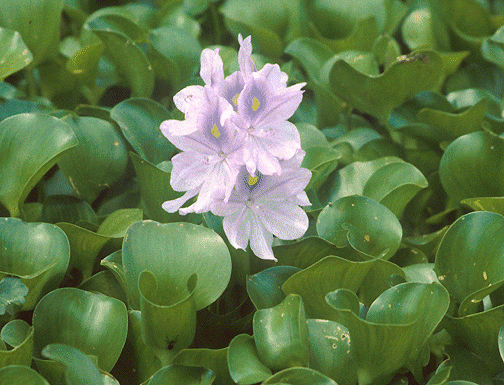
Water hyacinth (Eichhornia crassipes) is a large aquatic plant native to the Amazon basin. Its thick, waxy, oval-shaped leaves are 4-8 inches across and branch out from the center of the plant on modified stems that may rise as much as 1 meter above the water surface. The mass of fine roots that hang in the water underneath the plant are dark purple or black with small, white root-hairs. The stems are spongy, bulbous stalks (called petioles) that contain air-filled tissues that keep the plant afloat. When flowering, the stalks support 8 – 15 blue-violet flowers with six petals each, with one petal being deeper violet with a yellow spot.
Water hyacinth produces thousands of seeds each year, which can remain viable for up to 30 years.
One of the fastest growing plants known; water hyacinths can double populations in two weeks. Some populations in Southeast Asia have been documented to grow up to 5 meters per day. The plant is capable of reproduction by two vegetative methods: seeds and horizontal stems. Flowers open briefly during the summer before beginning to wither. When all the flowers have withered, the stalk gradually bends into the water and seeds are released and sink to the soil where they can remain viable for up to 30 years. Water hyacinth can also produce vegetatively by producing short runner stems (stolons) from the base of the plant to form daughter plants. Fragmentation, or breaking into smaller pieces, may occur by wind or wave action or the propellers of motor boats. Once broken apart, plant fragments are easily transported to new areas where they can reproduce and cause another infestation.
Water hyacinth mats are capable of attaining incredibly high plant density and biomass. A single hectare can contain more than 360 metric tons of plant biomass.
Water hyacinth is considered a noxious weed species in more than 50 countries. Water hyacinth was first introduced into the United States during the 1884 Cotton States Exposition in New Orleans. The plants were given as gifts to attendees, who later took them home to add to backyard ponds. By 1900, water hyacinths had escaped cultivation and become a serious pest. Today, water hyacinth occurs throughout the southeastern states, north to Virginia and west to Texas, and in California and Hawaii. Seasonal escapes from cultivation have been reported from New York, Kentucky, Tennessee and Missouri, but populations did not survive through the winter. The plant previously occurred in Arizona, Arkansas, and Washington State but is now considered eradicated in these locations. Water hyacinth is able to grow in a wide variety of water bodies from lakes, streams, ponds, waterways, ditches, and backwater areas, although it prefers, and grows most prolifically, in nutrient-enriched waters.
See the current distribution of water hyacinth in the United States

Water hyacinth is considered invasive throughout the world because it grows rapidly and can form thick layers over the water. These mats shade out the other aquatic plants. Eventually these shaded plants die and decay. The decaying process depletes the amount of dissolved oxygen in the water. As oxygen levels decline, many fish are unable to survive. Often the waters below water hyacinth masses become devoid of life.
After establishing in Africa’s Lake Victoria in 1989, water hyacinth eventually grew to cover approximately 77 square miles of the water body.
Dense plant mats also interfere with boat navigation and prevent fishing, swimming, and other recreational activities. Water hyacinth may also clog intake pipes used for drinking water, hydro power, or irrigation. Because the large plants have ample surface area, lake water levels may decrease due to evapo-transpiration, when water evaporates from the lake surface and is lost through plant leaves as vapor. Globally, water hyacinth is considered a serious threat to biodiversity and human health, creating prime habitat for mosquitoes which carry a variety of infectious diseases including Eastern Equine Encephalitis Virus (“triple E”) and West Nile Virus.
Most spread of water hyacinth can be attributed to human activity, including the deliberate planting of water hyacinth. The plant is sold in nurseries and online marketplaces for use in watergardens and home ponds, which may lead to accidental or intentional introductions. For example, major rainstorms can wash plants or seeds into adjacent waterways where they can flourish. Likewise, draining water or dumping plants into nearby waters can lead to new infestations. Water hyacinth can also be spread by hitchhiking on boats and other recreational equipment.
Like all invasive species, the key to preventing their spread is knowledge! You can help minimize the spread of this aquatic weed by following these simple steps: